Embracing AI in A&E Project Scheduling
Artificial intelligence (AI) is reshaping the landscape of Architecture and Engineering (A&E) project scheduling, offering unprecedented efficiency, accuracy, and collaboration in resource and risk management. This article explores how AI-powered platforms and tools revolutionize scheduling practices, optimize resource allocation, predict risks, and foster innovation and sustainability in modern A&E projects.
Understanding Resource Management in Project Scheduling
What is resource management in project management?
Resource management in project management is the systematic approach to planning, acquiring, allocating, and monitoring resources to ensure a project achieves its goals efficiently. It focuses on having the right resources available at the right time and balancing supply with project demands. This process covers labor, equipment, materials, and supports to maintain workflow and meet deadlines.
Why is resource management important for project success?
Effective resource management prevents the risks of overallocation, where resources are stretched too thin, or underutilization, where resources are idle. These imbalances can cause delays, increased costs, and reduced quality. By optimizing resource use, projects stay on schedule, reduce expenses, and improve outcomes. It helps maintain control over the project's progression and supports risk mitigation.
How does resource allocation and balancing work?
Resource allocation involves assigning tasks and responsibilities to available resources, based on project needs and constraints. Balancing means adjusting these assignments to avoid conflicts or bottlenecks. AI-powered platforms like ALICE automate these processes by rapidly generating and evaluating multiple scenarios, ensuring that labor, equipment, and materials are distributed effectively throughout the project timeline to maximize efficiency.
How is tracking and adjustment handled?
Continuous tracking of resource utilization empowers project managers to detect deviations from plans early. Tools that integrate AI provide real-time insights and can adapt schedules dynamically to respond to changes or unexpected events. This agility reduces downtime and enables proactive decision-making, resulting in smoother project execution.
| Aspect | Description | Benefit |
|---|---|---|
| Planning & Procurement | Identifying and securing necessary resources | Ensures availability when needed |
| Allocation & Balancing | Assigning tasks and adjusting workloads | Prevents over/underutilization |
| Tracking Utilization | Monitoring actual resource use | Enables timely problem detection |
| Adaptive Adjustment | Dynamic rescheduling based on data | Maintains project flow and reduces risks |
Incorporating AI-driven resource management within project scheduling ultimately leads to significant improvements in project duration, labor cost savings, and equipment efficiency, supporting a more predictable and successful project delivery.
Key Steps in Resource Management Planning for A&E Projects
What are the key steps involved in resource management planning for projects?
Resource management planning in Architecture and Engineering (A&E) projects requires a structured approach to align resources effectively with project demands. The process starts with reviewing project plans and resource needs. This involves examining critical documents such as the project charter, schedule, and risk management plans to understand what resources—human, material, and technological—are required.
The next step is estimating resources needed. Planners identify the types and quantities of personnel, materials, tools, and software necessary. This estimation also accounts for cost, availability, and how resources will be acquired to ensure feasibility.
Once resources are estimated, assigning resources becomes the focus. Allocation is done by matching the right skills and expertise with project tasks, considering availability, workload, and even individual interests. It's important to establish realistic timelines and budgets while also planning for training and potential contingency measures to mitigate risks.
Developing the resource management plan is the next crucial step. This plan lays out how resources will be allocated, managed, and monitored throughout the project. It includes metrics to track resource use and criteria for releasing resources when appropriate, ensuring that resource utilization aligns with project goals and organizational policies.
Finally, continuous monitoring ensures that resource deployment remains effective during the project lifecycle. Tracking usage and progress allows for adjustments to be made in response to unexpected challenges or changes, optimizing efficiency and supporting smooth execution.
This systematic approach is essential in complex A&E projects, especially when integrating advanced technologies like AI platforms (e.g., ALICE) that optimize resource allocation, scheduling, and risk management, reinforcing successful project delivery.
Benefits of Effective Resource Management in Project Delivery
How can effective resource management benefit project delivery?
Effective resource management plays a critical role in improving project outcomes. It starts with the optimal utilization of skills, where resources are matched carefully to tasks based on their capabilities and availability. This strategic alignment prevents underuse or overloading of personnel and equipment, enhancing overall productivity.
By scheduling resources accurately considering skill sets, location, and current workload, project managers reduce the likelihood of delays and conflicts. This proactive approach keeps projects progressing smoothly and helps avoid costly disruptions.
Real-time visibility into resource capacity combined with dynamic forecasting enables teams to anticipate shortages or bottlenecks early. Specialized scheduling platforms offer these insights, allowing for timely adjustments that minimize downtime and maximize efficiency.
Improved collaboration stems from centralized management tools that bridge organizational silos. Transparency in resource allocation fosters better communication and trust among stakeholders. When employees are assigned work aligned with their skills, their motivation and engagement increase, driving higher quality and timely project delivery.
In summary, effective resource management optimizes skill use, reduces scheduling conflicts, enhances forecasting capabilities, and strengthens team collaboration—directly benefiting the successful delivery of projects.
AI-Powered Tools Revolutionizing Resource Management Planning
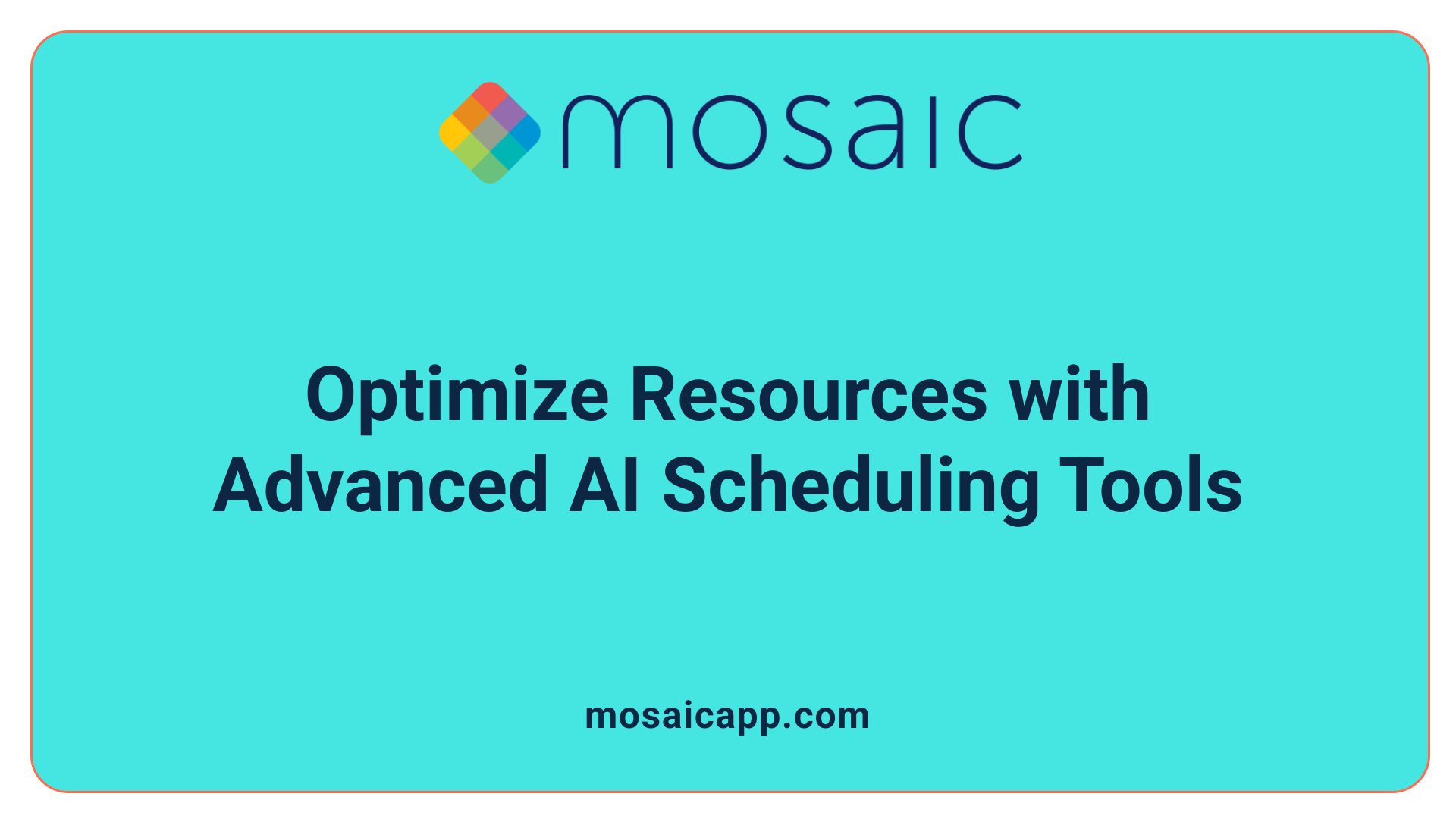
What tools or techniques are commonly used for resource management planning services?
Resource management planning in construction and architecture commonly relies on visual tools like Gantt charts and Kanban boards to schedule tasks and track resource usage. Industry-standard software such as Microsoft Project, Oracle Primavera, and Ganttic help managers monitor workloads, allocate resources precisely, and maintain transparency throughout the project lifecycle.
Techniques like resource leveling, resource smoothing, and forecasting are essential to balance workloads and prevent overallocation. These methods ensure resources are optimally utilized, reducing bottlenecks and scheduling conflicts, which are critical for complex projects.
How does AI enhance resource management planning?
AI-enhanced platforms like ALICE and Motion take resource planning further by automating scheduling tasks, rapidly generating multiple feasible project scenarios, and optimizing resource allocation based on real-time data and constraints. For example, ALICE integrates with existing schedules imported from Microsoft Project or Primavera and uses generative AI to produce optimized, adaptable schedules.
AI algorithms improve accuracy in cost estimation, risk prediction, and resource matching by analyzing historical project data. This reduces project durations by an estimated 17%, with labor and equipment cost savings of 14% and 12%, respectively. Moreover, AI-driven tools facilitate dynamic rescheduling to adapt swiftly to project changes or unexpected disruptions.
How is AI integrated with existing project management platforms?
AI-powered tools like ALICE smoothly import existing schedules from widely used platforms, ensuring continuity and data consistency. Integration allows AI to augment human planners' efforts rather than replace them—enabling enhanced scenario planning, risk management, and collaborative review.
Using natural language processing, AI solutions such as Planview Copilot let project managers interact conversationally with their data, retrieve insights, and update statuses without steep learning curves or disrupting workflows.
What automation and real-time adjustment capabilities does AI bring?
AI platforms automate routine scheduling tasks, constraint resolution, and scenario generation, significantly reducing planning times. Real-time project monitoring using IoT sensors and image recognition enables proactive identification of potential delays, safety hazards, or resource shortages.
Adaptive scheduling powered by neural networks can dynamically adjust resource allocation and timelines based on live data, ensuring projects remain on track despite uncertainties.
| Aspect | Traditional Tools | AI Enhancements | Benefits |
|---|---|---|---|
| Scheduling | Gantt charts, Kanban boards | Generative scheduling with multiple scenario outputs | Faster planning, optimized project duration |
| Resource Allocation | Manual leveling, smoothing | Automated matching of skills to tasks, dynamic adjustments | Reduced overbooking, better utilization |
| Integration | Standalone software (MS Project, Primavera) | Seamless import/export, conversational AI interfaces | Enhanced collaboration, easier adoption |
| Automation | Rule-based task assignment | AI-driven constraint solving, real-time monitoring | Time savings, proactive risk mitigation |
| Cost and Risk Estimation | Historical averages, manual analysis | Machine learning models improve accuracy and foresight | Cost reductions, early risk detection |
Handling Resource Conflicts and Shortages with AI Assistance
How do project managers handle resource conflicts or shortages during a project?
Project managers address resource conflicts and shortages by first establishing clear communication channels. Comprehensive resource management plans articulate resource needs upfront, helping stakeholders understand and prepare accordingly, which minimizes disputes.
Prioritization plays a critical role, with managers assessing tasks by their importance and deadlines. This enables the reallocation of existing resources or strategic redeployment of staff without causing burnout. When shortages cannot be resolved internally, negotiation with stakeholders for additional resources or adjusting project timelines becomes necessary.
To detect resource conflicts early, project managers often use resource leveling techniques combined with advanced resource management software. These tools highlight over-allocations and scheduling clashes, prompting timely interventions.
Contingency plans are crucial as well. Having approval and protocols in place ensures teams are prepared to implement alternative strategies efficiently if disputes emerge.
How can AI assist in resolving resource conflicts?
AI-powered platforms like ALICE enhance conflict resolution by rapidly exploring multiple scheduling scenarios and aligning resource allocations with project constraints.
These systems automate the detection of resource clashes by analyzing vast and complex datasets faster than traditional methods. Machine learning algorithms predict upcoming shortages based on historical data and ongoing project changes, enabling proactive adjustments.
Moreover, AI facilitates optimized resource prioritization by balancing workload distribution and identifying the most efficient allocation paths. It also supports contingency planning by generating alternative schedules instantly when disruptions occur.
By integrating AI tools, project managers gain real-time insights and visualization capabilities that improve collaboration among stakeholders, making conflict resolution more transparent and data-driven.
| Aspect | Traditional Approach | AI-Enhanced Approach |
|---|---|---|
| Communication | Resource plans & manual updates | Dynamic visualizations and real-time updates |
| Prioritization | Manual assessment and reallocation | AI-driven workload balancing and scenario analysis |
| Conflict Detection | Resource leveling techniques, software alerts | Automated clash detection via predictive analytics |
| Contingency Planning | Approved manual fallback plans | Rapid generation of alternative schedules |
| Collaboration | Stakeholder meetings and static reports | Interactive sharing platforms with AI-powered insights |
In summary, combining traditional project management with AI-powered assistance significantly improves handling of resource conflicts and shortages, driving project efficiency and resilience.
AI-Driven Generative Scheduling: The ALICE Platform Case Study
What are the generative scheduling capabilities of ALICE?
ALICE leverages artificial intelligence to automate the complex task of construction project scheduling. Its AI-driven generative scheduling can quickly produce multiple optimized plans by considering project constraints and resource availability. This automation resolves scheduling conflicts and reduces manual planning efforts, enabling dynamic adaptation to changes and minimizing risks through predictive insights.
How does ALICE enable rapid exploration of multiple project scenarios?
The platform allows users to generate and compare various feasible construction schedules instantly. By inputting project data and constraints, ALICE can explore alternative sequencing and resource allocation options, guiding project teams toward the most efficient and cost-effective schedules. This scenario exploration fosters informed decision-making and enhances overall project resilience.
Can ALICE import existing project schedules and how does this feature work?
ALICE supports importing existing schedules from popular tools like Microsoft Project and Oracle Primavera. Once imported, it analyzes the data and constraints to generate multiple alternative feasible schedules. This feature streamlines integration with current project management practices, allowing teams to enhance their scheduling approaches without starting from scratch.
What are the efficiency improvements and cost savings associated with ALICE?
Projects utilizing ALICE have demonstrated significant benefits, including a 17% reduction in overall project duration. Labor costs can decrease by 14%, while equipment expenses see savings around 12%. These efficiency gains stem from automated schedule constraint management, optimized resource allocation, and the ability to quickly adjust plans based on real-time insights—resulting in accelerated timelines and lowered operational costs.
Enhancing Risk Management and Decision-Making through AI
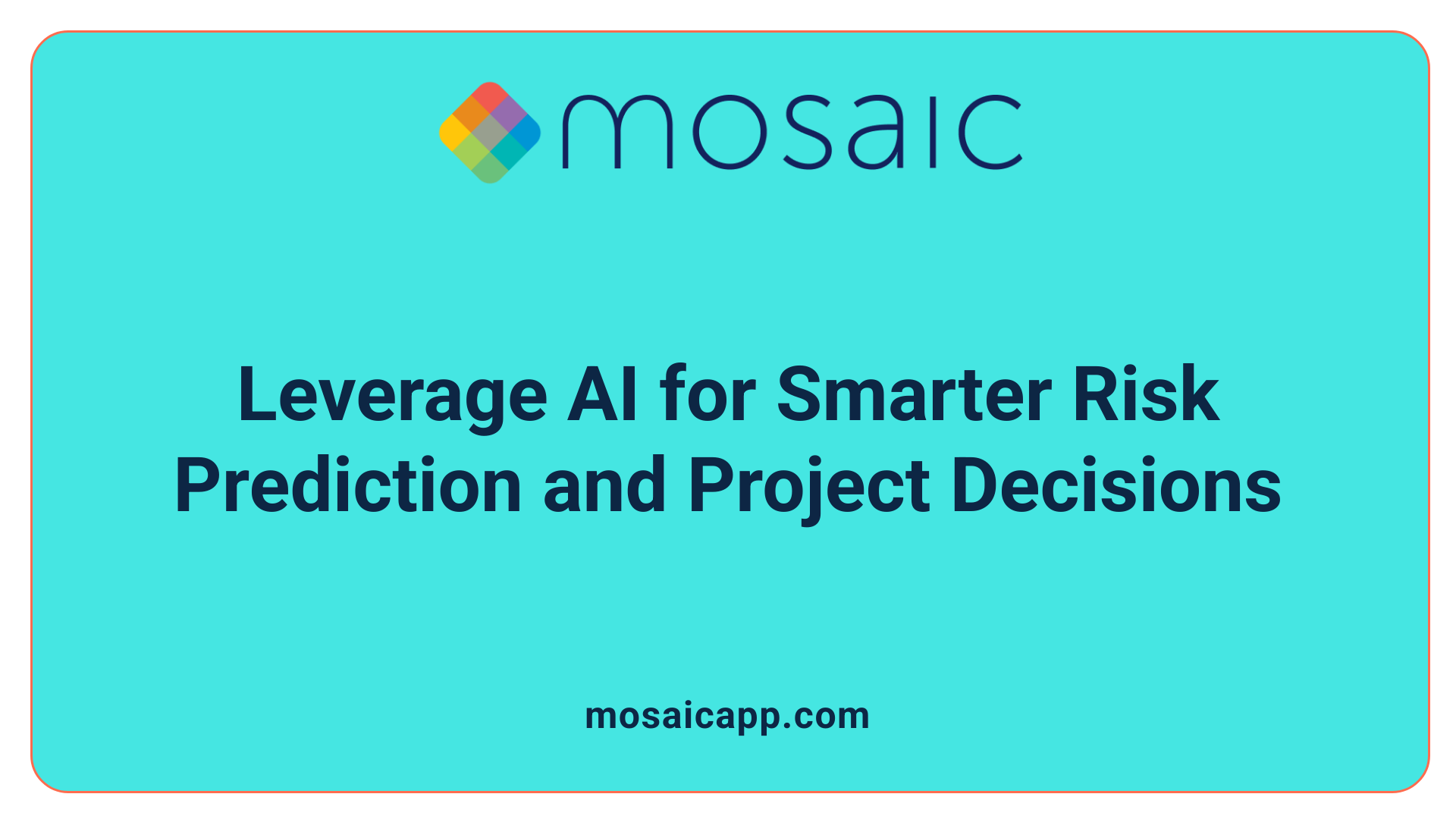
How does AI improve risk prediction and mitigation in construction projects?
AI significantly enhances risk management by analyzing vast amounts of project data to predict potential issues early. Tools like ALICE automate schedule constraint resolution and generate multiple project scenarios, helping to identify risks before they disrupt progress. AI-based risk prediction has been shown to reduce project costs by 15%, highlighting its effectiveness in mitigating unforeseen challenges.
In what ways does AI support value engineering in project planning?
Value engineering benefits from AI's ability to optimize resource allocation and explore alternative planning scenarios rapidly. ALICE, for example, provides users with insights into resource utilization and project constraints, supporting decision-making that balances cost, schedule, and quality. This leads to improvements such as a 17% reduction in project duration and labor and equipment cost savings of 14% and 12%, respectively.
How do real-time insights and dashboards enhance decision-making?
AI-powered platforms offer real-time monitoring through intuitive dashboards, integrating data from IoT sensors and image recognition systems for up-to-date site conditions. This enables proactive identification of schedule delays, cost overruns, and safety concerns. These real-time insights support adaptive management, allowing project teams to respond swiftly to changes and maintain project alignment.
By combining predictive analytics, automated scenario planning, and transparent visualizations, AI fosters more informed and agile decision-making processes, ultimately boosting project resilience and efficiency.
Improving Collaboration and Visualization with AI in Scheduling
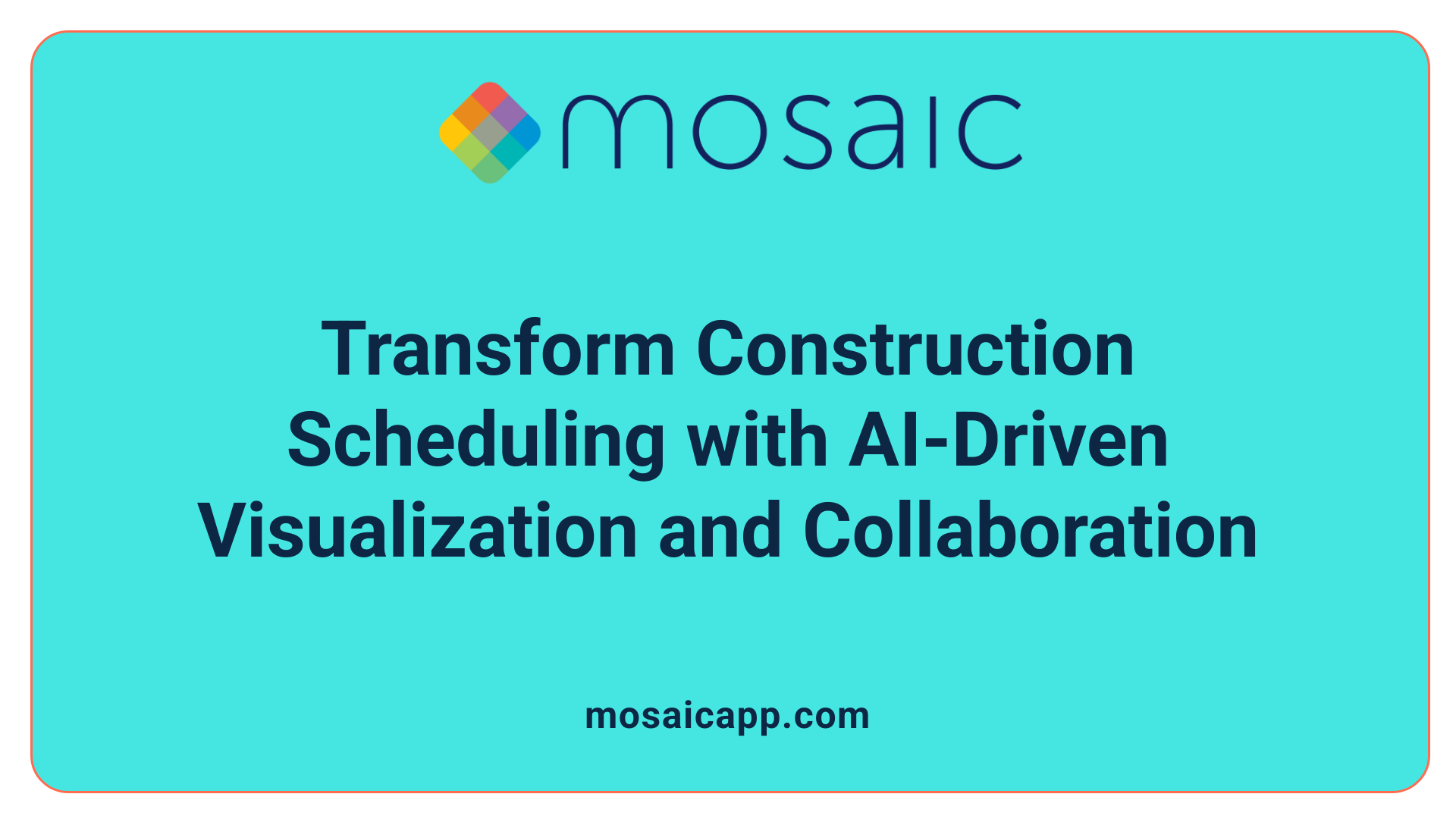
How does AI improve schedule visualization?
AI-powered platforms like ALICE transform construction project scheduling by creating dynamic and easily interpretable visualizations. These visual interfaces allow project managers and teams to explore multiple scheduling scenarios rapidly, highlighting timelines, dependencies, and resource allocation in a visually intuitive manner.
In what ways does it enhance stakeholder engagement?
By visualizing complex schedules, AI tools facilitate clear communication among stakeholders, including project planners, contractors, and clients. This transparency drives better alignment and enables stakeholders to participate actively in reviewing and adjusting plans, thereby improving collaboration and decision-making.
How does AI support plan sharing and export?
AI scheduling platforms provide seamless options to share and export detailed plans across various formats. Users can distribute schedules efficiently to relevant parties, ensuring consistent and up-to-date information exchange that supports synchronized execution across teams.
Can virtual and augmented reality be used to enhance schedule understanding?
Yes, integrating VR and AR technologies with AI-generated schedules offers immersive experiences that enhance comprehension of project timelines and workflows. These technologies enable stakeholders to virtually walkthrough the project’s phases, visualize resource utilization, and foresee potential challenges in a highly interactive environment.
Through these AI-enhanced visualization and collaboration capabilities, project management becomes more transparent, informed, and adaptive, ultimately contributing to smoother project delivery and stronger stakeholder relationships.
AI's Impact on Project Duration, Cost, and Efficiency in A&E Scheduling
How Does AI Reduce Project Duration?
AI-driven scheduling platforms like ALICE enable rapid exploration of multiple construction scenarios, optimizing resource use and mitigating risks. This approach leads to an average 17% reduction in project duration by generating dynamic schedules that adapt to changes and resolve constraints automatically.
What Savings Are Achieved in Labor and Equipment Costs?
By improving resource allocation and scenario planning, AI helps reduce labor costs by around 14% and equipment costs by 12%. Efficient scheduling minimizes idle times and prevents costly delays, contributing to significant overall project savings.
How Does Dynamic Scheduling Improve Efficiency?
Dynamic project scheduling powered by AI uses machine learning to analyze historical data and current constraints. This results in multiple feasible schedules that can adjust in real time. AI automates rescheduling and constraint resolution, drastically cutting planning time and enhancing accuracy.
In What Ways Is Accuracy Improved?
AI algorithms improve cost estimation accuracy from traditional levels of 85% up to 92%. Additionally, neural networks trained on historical project data enhance forecasting capabilities for cost and timelines. This helps project managers make data-driven decisions and reduces errors.
| Impact Area | Quantitative Benefit | Explanation |
|---|---|---|
| Project Duration | 17% reduction | AI rapidly generates and adapts optimal schedules |
| Labor Cost Savings | 14% savings | Efficient resource allocation reduces idle and overtime |
| Equipment Cost Savings | 12% savings | Optimized equipment usage and scheduling |
| Cost Estimation Accuracy | Improved from 85% to 92% | AI uses historical data and machine learning models |
AI significantly transforms architecture and engineering scheduling by advancing speed, reducing costs, and enhancing decision accuracy through intelligent automation and data-driven insights.
The Future Landscape: AI Trends and Predictions in Project Scheduling
How will AI transform project scheduling by 2026 and beyond?
AI is set to profoundly reshape project scheduling in the coming years. By 2026, the project management industry is expected to undergo a substantial transformation, with up to 70% of job titles shifting toward role-based descriptors driven by AI capabilities. This evolution will reflect the increasing integration of AI tools into everyday workflows, automating routine tasks and providing data-driven decision support.
Predictive scheduling powered by AI will allow project managers to foresee delays and budget overruns with more than 90% accuracy by 2028. This leap in forecasting will enable proactive adjustments that minimize disruptions and improve overall efficiency.
Furthermore, AI-driven dynamic scheduling will optimize resource allocation and adapt to changing project conditions in real time, fostering more resilient and efficient project plans. Through continuous learning from project data, AI platforms will keep enhancing their scheduling accuracy and responsiveness, supporting projects valued in the billions globally.
What role shifts are expected and how will predictive accuracy improve?
With AI capabilities embedded in project management, traditional positions will evolve to roles focusing on analytics, oversight, and strategy rather than manual planning. Project managers will increasingly work alongside AI assistants that help generate scenarios, anticipate risks, and suggest optimal scheduling solutions.
Machine learning models will significantly boost cost estimation accuracies from traditional levels near 85% to over 90%, while AI-driven risk prediction tools will help flag potential issues early, reducing costs by around 15%. Additionally, AI-enabled resource allocation can cut project completion times by 20%, streamlining workflows and improving outcomes.
Natural language interfaces, such as conversational AI tools, will improve communication and decision-making, making AI insights more accessible and actionable for teams.
What ethical and governance challenges must be addressed?
Despite these advancements, integrating AI into project scheduling raises important ethical and governance questions. Ensuring transparency in AI-driven decisions is critical to maintain stakeholder trust. Addressing data bias and algorithmic fairness must be priorities to avoid unfair or inaccurate project impacts.
Robust governance frameworks are needed to oversee AI use, including protecting sensitive project data and managing legal compliance. The development of ethical models tailored for AI in project management will support responsible adoption.
Ongoing professional development for project managers around AI literacy and ethical leadership will be essential to navigate this new landscape responsibly. The human-AI collaboration balance remains pivotal, with human oversight required to guide ethical decision-making and ensure AI augments rather than replaces critical human judgment.
Integrating AI with Human Oversight: Ethical and Practical Considerations
What ethical frameworks support AI integration in project management?
Integrating AI into project management demands clear ethical frameworks to ensure transparency, fairness, and stakeholder trust. Models such as the AI-Augmented Ethics-Centric Model and the Predictive Model for AI Adoption and Human Trust provide structured guidelines for responsible use. They emphasize the necessity of transparency in AI decision-making and accountability in automated processes.
How can human-AI collaboration be effectively achieved?
Successful project management depends on balancing AI capabilities with human judgment. AI tools automate scheduling, risk analysis, and resource allocation, yet human oversight remains vital for interpreting results, handling ethical concerns, and making final decisions. This partnership should foster trust through transparency and clear communication, ensuring AI augments rather than replaces project managers.
Why is training and AI literacy important?
Project managers and teams must acquire AI literacy to fully harness AI’s potential. Continuous education and training improve understanding of AI functions, limitations, and ethics. This empowers staff to identify data biases, security vulnerabilities, and evaluate AI-generated insights critically, ultimately enhancing project outcomes and innovation.
How are biases and data security addressed in AI implementations?
Bias in AI algorithms and data misuse pose significant risks. Addressing these requires robust governance frameworks focused on algorithmic fairness, regular audits, and monitoring to detect bias. Protecting sensitive project data through stringent security protocols ensures confidentiality and complies with legal standards. Ongoing updates and ethical leadership reinforce these safeguards to maintain project integrity.
Together, ethical frameworks, informed human oversight, comprehensive training, and proactive bias and security measures form the foundation for responsible AI use in project management. This integrated approach supports transparent, effective, and trustworthy AI adoption that benefits modern construction and infrastructure projects worldwide.
AI's Contribution to Sustainable Design and Execution in A&E Projects
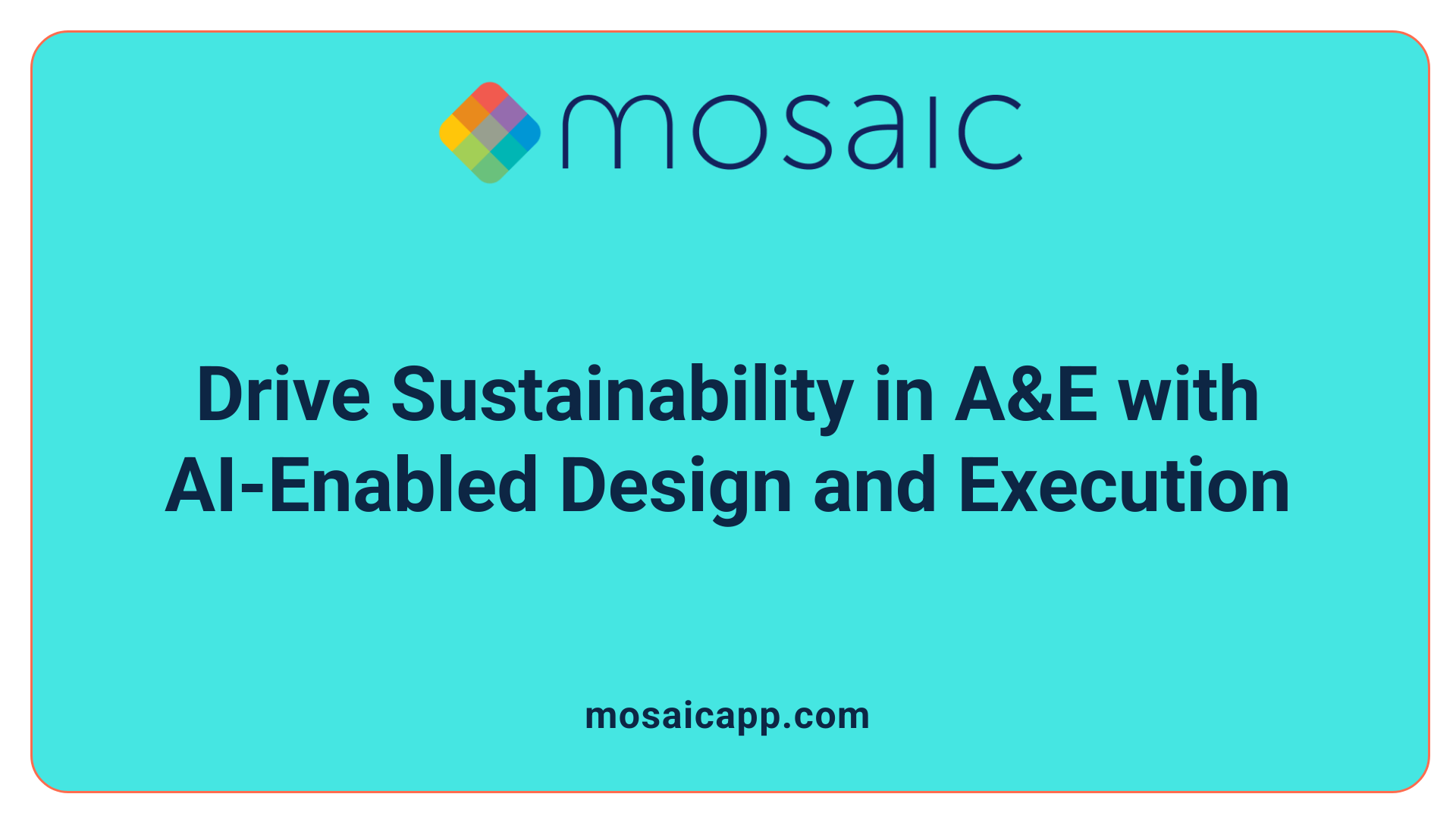
Generative Design for Efficient Layouts
AI-powered generative design algorithms enable architects and engineers to explore a vast number of layout and structural configurations rapidly. This technology helps optimize building forms for both functionality and sustainability, automating routine aspects like clash detection and layout adjustments. By generating innovative design options aligned with project goals, AI supports creative and efficient architectural solutions.
Energy Efficiency Analysis
AI tools analyze building models to evaluate energy consumption patterns and recommend improvements. By simulating energy use, these systems identify opportunities to enhance efficiency through design choices and operational strategies. This data-driven approach ensures sustainable outcomes, reducing the environmental footprint of projects from early-stage planning through execution.
Material Recommendations
Sustainability in architecture benefits from AI’s capacity to assess materials based on environmental impact, durability, and cost. AI recommends eco-friendly materials tailored to project constraints, helping reduce the carbon footprint while maintaining quality and performance standards.
Carbon Reduction Initiatives
Specific AI applications in projects emphasize carbon footprint reduction by integrating early-stage analysis and optimization. Examples include Stantec’s use of AI for early carbon analysis and developments like The Phoenix housing project showcasing AI's capability to streamline sustainability efforts. These initiatives demonstrate how AI supports low-carbon design and construction practices effectively.
Collectively, AI enhances sustainable design and execution by providing advanced tools that balance innovation, efficiency, and environmental responsibility in architecture and engineering projects.
Overcoming Implementation Challenges of AI in A&E Scheduling
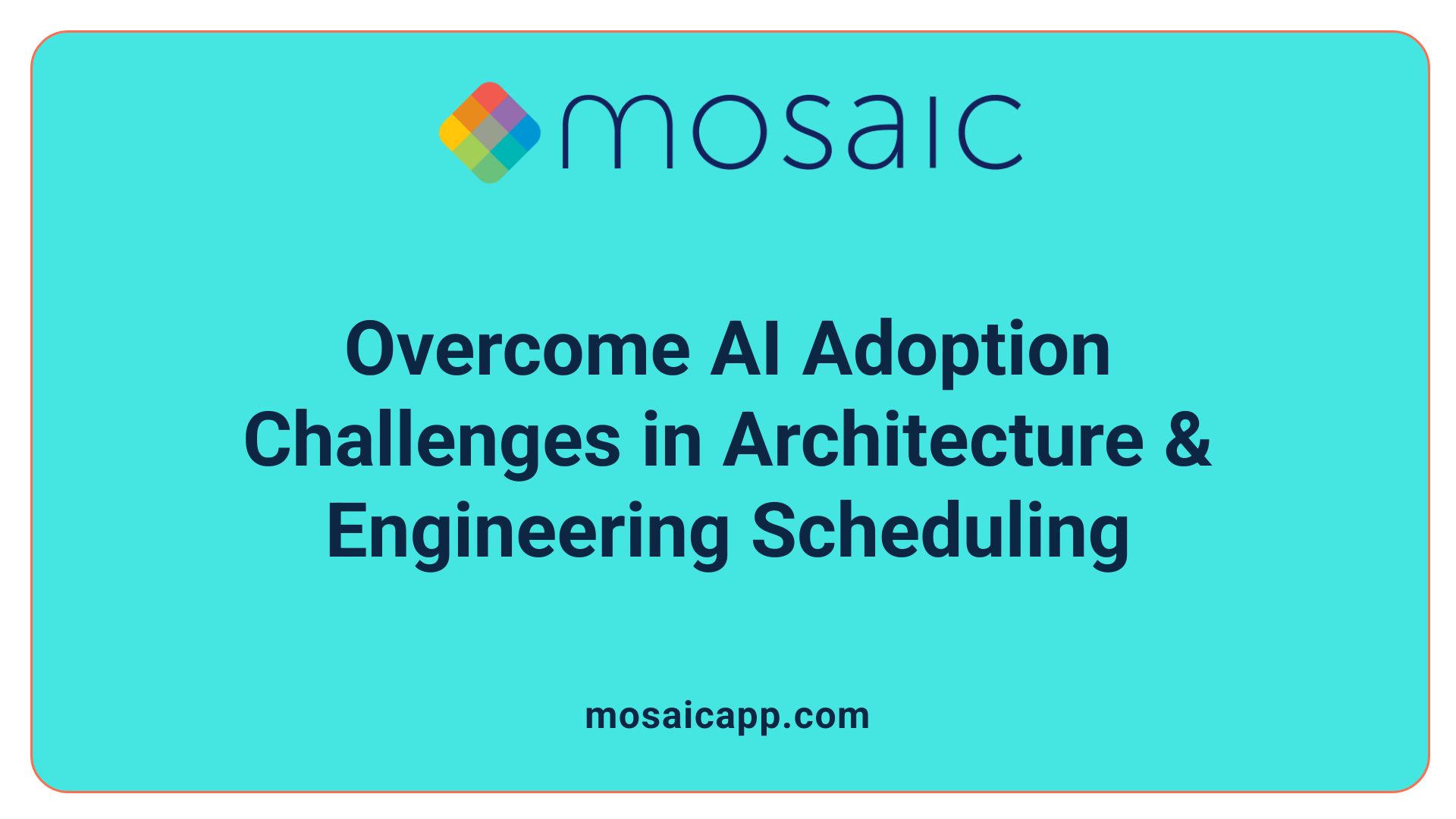
High Initial Investment and Training
Adopting AI technologies in architecture and engineering (A&E) scheduling often involves significant upfront costs. These include purchasing advanced software, integrating AI tools with existing systems, and investing in training programs to equip staff with the necessary skills. The steep learning curve requires time and resources to ensure personnel can effectively leverage AI capabilities, from generative scheduling to risk mitigation.
Resistance to Change
Organizational resistance poses another significant hurdle. Teams accustomed to traditional scheduling and management workflows may hesitate to embrace AI-driven methods. This reluctance stems from uncertainties about AI’s reliability, fears of job displacement, and discomfort with new technology interfaces. Overcoming this requires transparent communication, demonstrating AI’s role as a collaborative aid that enhances human decision-making rather than replaces it.
Data Fragmentation
AI-driven scheduling thrives on comprehensive and standardized project data. However, fragmented and non-standardized data ecosystems prevalent in many organizations hinder seamless AI implementation. Disparate software platforms, inconsistent data formats, and siloed information reduce the accuracy and effectiveness of AI-generated schedules and insights.
Phased Adoption and Cloud Solutions
To address these challenges, a phased adoption strategy is effective. Starting with pilot programs on select projects allows gradual integration while assessing benefits and refining workflows. Additionally, cloud-based AI solutions offer scalable, cost-efficient deployment with easier updates and collaboration capabilities. Cloud platforms can mitigate data fragmentation by centralizing project information and enabling real-time access for stakeholders.
By combining thoughtful investment, staff training, proactive change management, and cloud-facilitated phased adoption, A&E firms can successfully surmount challenges and unlock AI’s full potential in scheduling optimization and project delivery.
Navigating the AI-Enabled Future of A&E Project Scheduling
AI is rapidly becoming an indispensable tool in Architecture and Engineering project scheduling by automating resource management, enhancing risk prediction, and fostering collaborative decision-making. Platforms like ALICE demonstrate tangible benefits such as reduced project durations and cost savings, signaling a new era of efficiency and innovation. However, successful adoption hinges on ethical implementation, continuous human oversight, and addressing challenges related to data integration and workforce readiness. Embracing AI with a balanced, informed approach will empower A&E professionals to deliver projects that are not only timely and cost-effective, but also sustainable and resilient, positioning the industry for continued evolution and growth in the coming decades.
References
- ALICE | AI Construction Project Schedule Optimization Software
- Using Artificial Intelligence for Project Management
- Application of Artificial Intelligence in Project Management
- Impact of artificial intelligence on project management (PM)
- How AI in architecture is shaping the future of design, ...
- Artificial intelligence in construction project management
- 6 Resource Planning Tools and Their Benefits
- 5 best resource management tools (tested & ranked)


